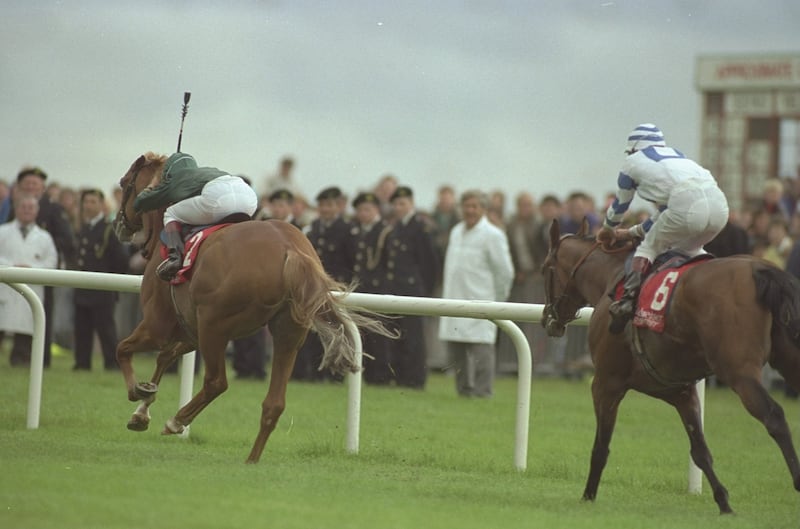Individual self-interest will decide who shouts for what in Sunday’s Dubai Duty Free Irish Derby but, for the sake of its overall reputation, Ireland’s premier classic really needs Auguste Rodin to line up and win.
Aidan O’Brien’s Epsom hero is the highest rated three-year-old colt in Europe right now. He is also perhaps the world’s most valuable stallion prospect. His scheduled appearance on Sunday is a major boost to a classic that has been leaking lustre in recent years.
A race with Nijinsky, Shergar and Galileo on its roll of honour is no longer an automatic option for Europe’s best three-year-olds. Those legendary names are among an exclusive list of 18 to complete the Epsom-Curragh Derby double. A lot of prestige is riding on Auguste Rodin becoming number 19.
The fact there wasn’t a flicker of hope that the brilliant Ace Impact might attempt to become the fifth horse to win the French Derby and follow up at the Curragh underlines how important Auguste Rodin’s appearance is. He will bring vital star quality to a race in need of dazzle.
Blood Destiny Paul Townend’s pick for Grade Two Thurles highlight
Energumene hoping to overcome veteran status in Clarence House clash with Jonbon
Irish racing not taking the initiative on ‘wastage’ is a costly strategic blunder
Leopardstown attendance at Dublin Racing Festival capped at 18,500 and all tickets to be pre-booked
Time was the Curragh’s position as the third of Europe’s major Derby prizes could produce classic “decider” scenarios between the winners at Epsom and Chantilly. Perhaps the most memorable was Generous’ epic defeat of Suave Dancer in 1991. But that was then and now is different.
France’s decision to drop the Prix Du Jockey Club distance in 2005 reflected the bloodstock industry’s commercial shift from mile and a half accomplishment. Only once since has a French Derby winner proceeded to the Curragh.
Commercial priorities have also turned some recent Epsom victors towards ten-furlong targets like Sandown’s Eclipse rather than the Curragh so out of fashion has the stamina required to win at the longer distance become.
It’s a rich irony then how the most commercial bloodstock enterprise of all, Coolmore, has been at the vanguard of an industry focus towards speed and, yet, without their support, both Derbies at Epsom and the Curragh would be under even more pressure than they already are.

That support has underpinned Aidan O’Brien’s Irish Derby dominance which, in turn, has produced competitive issues that have prompted dilution of the race’s popular appeal. All of it has contributed to the Irish Derby’s struggle for relevance in elite bloodstock terms.
It’s a problem that, in the short-term, could be sorted out by simply aping the French and cutting the race distance to a mile and a quarter.
Do that and it opens a scenario where the Curragh is an automatic option for those that have run in the Jockey Club while also fulfilling a role for those connections desperate to prove an Epsom winner’s speed at a shorter trip.
In such a framework, the competition aspect would take care of itself with the likelihood of greater public interest too. It would also increase the Irish Derby’s industry relevance with not so many of its winners condemned to stud careers as National Hunt stallions.
It is 40 years since the Curragh’s St Leger was opened to older horses, a move fundamentally at odds with the classic tradition of three-year-olds only. It was a step crucial to preserving the race’s Group One status, however.
Cutting the Derby trip is an easy argument to make when it appears needs must. Racing fashions change. Time also was when the Ascot Gold Cup at two-and-a-half miles was the ultimate prize. Nowadays, no one tries to breed a Gold Cup winner unless it’s of the Cheltenham variety.
It’s a knee-jerk option that should be resisted, though, and not just because it would bin a century and a half of tradition. The Leger move proved not being a hostage to heritage can pay off. Commercial fixations change, however, and, in the long term, might alternate in favour of the Irish Derby’s status quo.
[ IHRB thrown into disarray by ‘bombshell’ revelation of ‘grave financial concern’Opens in new window ]
Auguste Rodin could be a sign of that. As a product of the legendary Japanese sire Deep Impact out of a mare by Galileo, he is a living breathing mix of the best of racing’s old world and the emergence of Japan as the sport’s newest superpower.
Coolmore have been characteristically quick off the mark in tapping into a market where speed allied to middle distance stamina is prized. Cheap speed holds little appeal in Japan. Deep Impact himself never ran below ten furlongs and won at two miles.
Such a profile would be a commercial write-off in Europe, conveniently ignoring how Galileo himself, the prepotent stallion of the last two decades, only won at the top level at a mile and a half, including the 2001 Irish Derby, and wound-up siring champions at most every distance.
Should Auguste Rodin get beaten on Sunday, there will be plenty “told you so” merchants eager to pin a measure of blame on the race itself. Enough prejudices will be confirmed to spell bad news for the Irish Derby’s reputation.
Success, however, might be a welcome glimpse of a longer-term outlook where the class to carry speed over distance gets rightfully prized again.
Something for the Weekend
NEVER ENDING STORY (3.25) has been bumping heads against the outstanding French filly Blue Rose Cen this season. She is one of a pair of three-year-old’s in Saturday’s Pretty Polly Stakes at the Curragh and the 10lb concession from older rivals could tip the Group One prize in her favour.
One of the bottomweights for Saturday’s concluding handicap is CRYSTAL CAVES (5.40) who has her second start in Ireland. Rising star Jamie Powell takes 5lbs off and a step up to two miles could suit.






